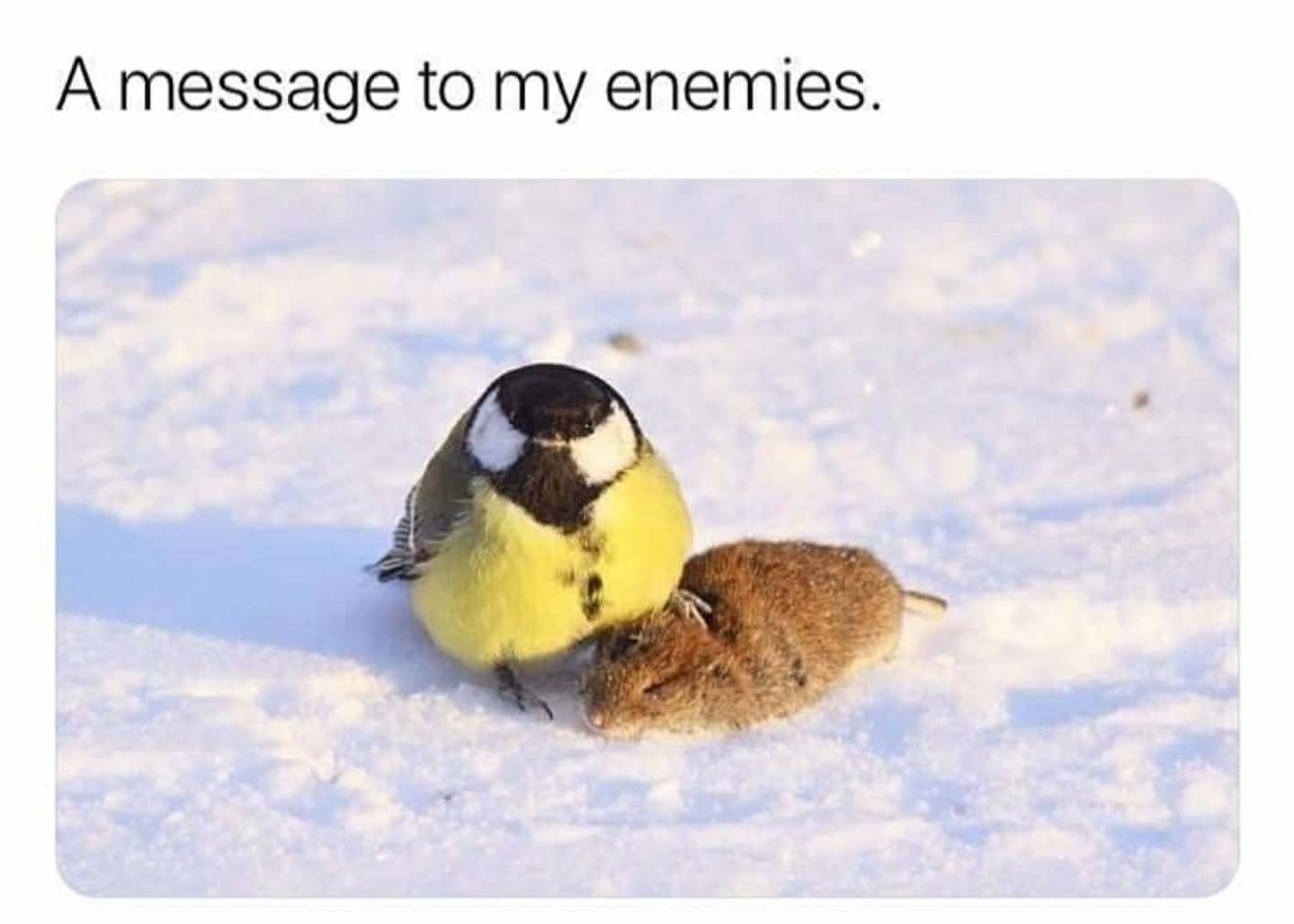The Unsuspected Killer
Perhaps you think this bird's all cute and funny, posing with its dead trophy. But laugh not, for tits can get bloodthirsty.
Very bloodthirsty.
Songbirds (suborder Passeri) are animals with various foraging strategies. While you mostly come across those species that eat seeds, berries or insects, you will also find such songbirds that want some meat.

Original image by Sami Majonein
The story behind this image is slightly more dramatic and gory than you'd expect - a sparrowhawk (Accipiter nisus) killed this (common?) vole (tribe Arvicolini), got into a conflict with a Eurasian magpie (Pica pica), which made the sparrowhawk drop the vole. The vole was found by a great tit (Parus major), which then ate the vole's brain. Only its brain.
So, this bird isn't an actual killer, just an opportunist, right? Well, not quite.
Tits actually kill warm-blooded animals quite often, especially in winter when their favourite food is scarce. They have been found guilty of killing redpolls (Acanthis flammea) or yellowhammers (Emberiza citrinella), sparrows and even bats hibernating in their caves. But all they seem to want is the brain.
Oh, and it gets darker! It's not only hunger that makes these birds turn into killing machines. It's also competition, which makes this meme even more accurate.
After mild winters European pied flycatchers (Ficedula hypoleuca) returning from their African wintering grounds discover that their nesting sites had already been occupied by great tits and blue tits, and this leads to fights. As a result, as many as one in ten pied flycatcher males are found dead in great tit nests every year.
For now, it seems that tits only kill surplus males that return to Europe way too late to successfully breed. But as climate change makes European winters milder and milder and breeding seasons start early, the future does not look good for the migratory birds - their conflicts with great tits are expected to get worse.

Photo credit: xulescu_g
| Common name: | Great tit |
| Scientific name: | Parus major |
| Phylum: | Chordata |
| Class: | Aves |
| Order: | Passeriformes |
| Family: | Paridae |
| IUCN status: | Least Concern |
| Population trend: | Increasing |
| Scientific reading: |

Photo credit: gailhampshire
| Common name: | Eurasian sparrowhawk |
| Scientific name: | Accipiter nisus |
| Phylum: | Chordata |
| Class: | Aves |
| Order: | Accipitriformes |
| Family: | Accipitridae |
| IUCN status: | Least Concern |
| Population trend: | Stable |
| Scientific reading: |

| Common name: | Common vole |
| Scientific name: | Microtus arvalis |
| Phylum: | Chordata |
| Class: | Mammalia |
| Order: | Rodenta |
| Family: | Cricetidae |
| IUCN status: | Least Concern |
| Population trend: | Stable |
| Scientific reading: |

Photo credit: Annette Meyer (Public domain)
| Common name: | Eurasian magpie |
| Scientific name: | Pica pica |
| Phylum: | Chordata |
| Class: | Aves |
| Order: | Passeriformes |
| Family: | Corvidae |
| IUCN status: | Least Concern |
| Population trend: | Stable |
| Scientific reading: |

Photo credit: Estormiz
| Common name: | Common redpoll |
| Scientific name: | Acanthis flammea |
| Phylum: | Chordata |
| Class: | Aves |
| Order: | Passeriformes |
| Family: | Fringilidae |
| IUCN status: | Least Concern |
| Population trend: | Decreasing |
| Scientific reading: |

Photo credit (GNU): Martin Mecnarowski
| Common name: | Yellowhammer |
| Scientific name: | Emberiza citrinella |
| Phylum: | Chordata |
| Class: | Aves |
| Order: | Passeriformes |
| Family: | Emberizidae |
| IUCN status: | Least Concern |
| Population trend: | Decreasing |
| Scientific reading: |

Photo credit: Lars Falkdalen Lindahl
| Common name: | European pied flycatcher |
| Scientific name: | Ficedula hypoleuca |
| Phylum: | Chordata |
| Class: | Aves |
| Order: | Passeriformes |
| Family: | Muscicapidae |
| IUCN status: | Least Concern |
| Population trend: | Decreasing |
| Scientific reading: |